The Application of Terrestrial Light Detection and Ranging to Forest Resource Inventories for Timber Yield and Carbon Sink Estimation
Abstract
1. Introduction
2. Materials and Methods
2.1. Study Site and Materials
2.2. Field Survey Methods and Data Collection Using LiDARs
2.3. Extraction of Forest Variables
- Plot extraction—extracting only points within a sample point (20 × 20 m) of the entire point cloud;
- Noise filtering—removing outliers caused by multipath effects of laser pulses from the data tasks to improve quality;
- Ground point classification—separating the terrain using the triangulated irregular network (TIN) algorithm;
- Attribute allocation—giving each point cloud a property value for (e.g., entry, understory vegetation, buildings, etc.);
- Stem extraction—extracting stands using the CSP algorithm.
2.4. Comparison of the Amount of Time Spent on Tasks for Efficiency Assessment
2.5. Statistical Analysis
3. Results and Discussion
3.1. Stem Detection
3.2. Height and DBH Measurement Accuracy Assessment
3.3. Statistical Goodness of Fit for Each Method
3.4. Efficiency Assessment of the LiDAR Devices
4. Conclusions
Author Contributions
Funding
Acknowledgments
Conflicts of Interest
References
- Bauwens, S.; Bartholomeus, H.; Calders, K.; Lejeune, P. Forest inventory with terrestrial LiDAR: A comparison of static and hand-held mobile laser scanning. Forests 2016, 7, 127. [Google Scholar] [CrossRef]
- Hyyppä, E.; Kukko, A.; Kaijaluoto, R.; White, J.C.; Wulder, M.A.; Pyörälä, J.; Liang, X.; Yu, X.; Wang, Y.; Kaartinen, H.; et al. Accurate derivation of stem curve and volume using backpack mobile laser scanning. ISPRS J. Photogramm. Remote Sens. 2020, 161, 246–262. [Google Scholar] [CrossRef]
- Wang, Y.; Lehtomäki, M.; Liang, X.; Pyörälä, J.; Kukko, A.; Jaakkola, A.; Liu, J.; Feng, Z.; Chen, R.; Hyyppä, J. Is field-measured tree height as reliable as believed—A comparison study of tree height estimates from field measurement, airborne laser scanning and terrestrial laser scanning in a boreal forest. ISPRS J. Photogramm. Remote Sens. 2019, 147, 132–145. [Google Scholar] [CrossRef]
- Päivinen, R.; Merja, N.; Kari, T.K. Accuracy of certain tree measurements, Puutunnusten mittaamisen luotettavuus. Folia For. 1992, 787, 1–18. [Google Scholar]
- Kitahara, F.; Mizoue, N.; Yoshida, S. Effects of training for inexperienced surveyors on data quality of tree diameter and height measurements. Silva Fenn. 2010, 44, 657–667. [Google Scholar] [CrossRef]
- Rutzinger, M.; Kumar, A.P.; Oude Elberink, S.; Vosselman, G. Detection and modelling of 3d trees from mobile laser scanning data. Int. Arch. Photogramm. Remote Sens. Spat. Inf. Sci. 2010, 38, 520–525. [Google Scholar]
- Maltamo, M.; Næsset, E.; Vauhkonen, J. Forestry applications of airborne laser scanning. Concepts and Case Studies. Manag. For. Ecosys 2014, 27, 460. [Google Scholar]
- Chen, S.; Liu, H.; Feng, Z.; Shen, C.; Chen, P. Applicability of personal laser scanning in forestry inventory. PLoS ONE 2019, 14, e0211392. [Google Scholar] [CrossRef]
- Chambers, J.Q.; Asner, G.P.; Morton, D.C.; Anderson, L.O.; Saatchi, S.S.; Espírito-Santo, F.D.; Palace, M.; Souza Jr, C. Regional ecosystem structure and function: Ecological insights from remote sensing of tropical forests. Trends Ecol. Evol. 2007, 22, 414–423. [Google Scholar] [CrossRef]
- Næsset, E. Predicting forest stand characteristics with airborne scanning laser using a practical two-stage procedure and field data. Remote Sens. Environ. 2002, 80, 88–99. [Google Scholar] [CrossRef]
- Popescu, S.C.; Wynne, R.H.; Nelson, R.F. Measuring individual tree crown diameter with lidar and assessing its influence on estimating forest volume and biomass. Can. J. Remote Sens. 2003, 29, 564–577. [Google Scholar] [CrossRef]
- Næsset, E. Airborne laser scanning as a method in operational forest inventory: Status of accuracy assessments accomplished in Scandinavia. Scand. J. Forest Res. 2007, 22, 433–442. [Google Scholar] [CrossRef]
- Li, W.; Guo, Q.; Jakubowski, M.K.; Kelly, M. A new method for segmenting individual trees from the lidar point cloud. Photogramm. Eng. Remote Sens. 2012, 78, 75–84. [Google Scholar] [CrossRef]
- Vastaranta, M.; Wulder, M.A.; White, J.C.; Pekkarinen, A.; Tuominen, S.; Ginzler, C.; Kankare, V.; Holopainen, M.; Hyyppä, J.; Hyyppä, H. Airborne laser scanning and digital stereo imagery measures of forest structure: Comparative results and implications to forest mapping and inventory update. Can. J. Remote Sens. 2013, 39, 382–395. [Google Scholar] [CrossRef]
- Barrett, F.; McRoberts, R.E.; Tomppo, E.; Cienciala, E.; Waser, L.T. A questionnaire-based review of the operational use of remotely sensed data by national forest inventories. Remote Sens. Environ. 2016, 174, 279–289. [Google Scholar] [CrossRef]
- Cao, L.; Pan, J.; Li, R.; Li, J.; Li, Z. Integrating airborne LiDAR and optical data to estimate forest aboveground biomass in arid and semi-arid regions of China. Remote Sens. 2018, 10, 532. [Google Scholar] [CrossRef]
- Cabo, C.; Del Pozo, S.; Rodríguez-Gonzálvez, P.; Ordóñez, C.; González-Aguilera, D. Comparing terrestrial laser scanning (TLS) and wearable laser scanning (WLS) for individual tree modeling at plot level. Remote Sens. 2018, 10, 540. [Google Scholar] [CrossRef]
- Watt, P.J.; Donoghue, D.N.M. Measuring forest structure with terrestrial laser scanning. Int. J. Remote Sens. 2005, 26, 1437–1446. [Google Scholar] [CrossRef]
- Maas, H.G.; Bienert, A.; Scheller, S.; Keane, E. Automatic forest inventory parameter determination from terrestrial laser scanner data. Int. J. Remote Sens. 2008, 29, 1579–1593. [Google Scholar] [CrossRef]
- Moskal, L.M.; Zheng, G. Retrieving forest inventory variables with terrestrial laser scanning (TLS) in urban heterogeneous forest. Remote Sens. 2012, 4, 1–20. [Google Scholar] [CrossRef]
- Koreň, M.; Mokroš, M.; Bucha, T. Accuracy of tree diameter estimation from terrestrial laser scanning by circle-fitting methods. Int. J. Appl. Earth Obs. Geoinf. 2017, 63, 122–128. [Google Scholar] [CrossRef]
- Guan, H.; Su, Y.; Sun, X.; Xu, G.; Li, W.; Ma, Q.; Wu, X.; Wu, J.; Liu, L.; Guo, Q. A marker-free method for registering multi-scan terrestrial laser scanning data in forest environments. ISPRS J. Photogramm. 2020, 166, 82–94. [Google Scholar] [CrossRef]
- Liang, X.; Hyyppä, J. Automatic stem mapping by merging several terrestrial laser scans at the feature and decision levels. Sensors 2013, 13, 1614–1634. [Google Scholar] [CrossRef] [PubMed]
- Dassot, M.; Colin, A.; Santenoise, P.; Fournier, M.; Constant, T. Terrestrial laser scanning for measuring the solid wood volume, including branches, of adult standing trees in the forest environment. Comput. Electron. Agric. 2012, 89, 86–93. [Google Scholar] [CrossRef]
- Calders, K.; Newnham, G.; Burt, A.; Murphy, S.; Raumonen, P.; Herold, M.; Culvenor, D.; Avitabile, V.; Disney, M.; Armston, J.; et al. Nondestructive estimates of above-ground biomass using terrestrial laser scanning. Methods Ecol. Evol. 2015, 6, 198–208. [Google Scholar] [CrossRef]
- Kankare, V.; Holopainen, M.; Vastaranta, M.; Puttonen, E.; Yu, X.; Hyyppä, J.; Vaaja, M.; Hyyppä, H.; Alho, P. Individual tree biomass estimation using terrestrial laser scanning. ISPRS J. Photogramm. 2013, 75, 64–75. [Google Scholar] [CrossRef]
- Hackenberg, J.; Spiecker, H.; Calders, K.; Disney, M.; Raumonen, P. SimpleTree —An efficient open source tool to build tree models from TLS clouds. Forests 2015, 6, 4245–4294. [Google Scholar] [CrossRef]
- Lefsky, M.; McHale, M.R. Volume estimates of trees with complex architecture from terrestrial laser scanning. J. Appl. Remote Sens. 2008, 2, 023521. [Google Scholar]
- Huang, H.; Li, Z.; Gong, P.; Cheng, X.; Clinton, N.; Cao, C.; Ni, W.; Wang, L. Automated methods for measuring DBH and tree heights with a commercial scanning lidar. Photogramm. Eng. Remote Sens. 2011, 77, 219–227. [Google Scholar] [CrossRef]
- Hyyppä, E.; Xiaowei, Y.; Harri, K.; Teemu, H.; Antero, K.; Mikko, V.; Juha, H. Comparison of backpack, handheld, under-canopy UAV, and above-canopy UAV laser scanning for field reference data collection in boreal forests. Remote Sens. 2020, 12, 3327. [Google Scholar] [CrossRef]
- García, M.; Danson, F.M.; Riaño, D.; Chuvieco, E.; Ramirez, F.A.; Bandugula, V. Terrestrial laser scanning to estimate plot-level forest canopy fuel properties. Int. J. Appl. Earth Obs. Geoinf. 2011, 13, 636–645. [Google Scholar] [CrossRef]
- Kweon, H.K.; Seo, J.I.; Lee, J.W. Assessing the applicability of mobile laser scanning for mapping forest roads in the republic of Korea. Remote Sens. 2020, 12, 1502. [Google Scholar] [CrossRef]
- Saarela, S.; Johannes, B.; Pasi, R.; Anton, G.; Goran, S.; Mark, J.D.; Rasmus, A. Kriging prediction of stand-level forest information using mobile laser scanning data adjusted for nondetection. Can. J. For. Res. 2017, 47, 1257–1265. [Google Scholar] [CrossRef]
- Del Perugia, B.; Giannetti, F.; Chirici, G.; Travaglini, D. Influence of scan density on the estimation of single-tree attributes by hand-held mobile laser scanning. Forests 2019, 10, 277. [Google Scholar] [CrossRef]
- Ko, C.U.; Lee, S.H.; Yim, J.S.; Kim, D.G.; Kang, J.T. Comparison of forest inventory methods at plot-level between a backpack personal laser scanning (BPLS) and conventional equipment in Jeju Island, South Korea. Forests 2021, 12, 308. [Google Scholar] [CrossRef]
- The VL Vertex Laser. Available online: http://www.haglofcg.com/index.php/en/files/leaflets/46-vl5-product-sheet (accessed on 8 September 2022).
- Leica. Leica RTC360 3D Reality Capture Solution. 2022. Available online: https://leica-geosystems.com/products/laser-scanners/scanners/leica-rtc360 (accessed on 8 September 2022).
- LiBackpack. Mobile Handheld LiDAR—3D Mapping System. Available online: https://greenvalleyintl.com/hardware/libackpack/ (accessed on 8 September 2022).
- Tao, S.; Wu, F.; Guo, Q.; Wang, Y.; Li, W.; Xue, B.; Hu, X.; Li, P.; Tian, D.; Li, C.; et al. Segmenting tree crowns from terrestrial and mobile LiDAR data by exploring ecological theories. ISPRS J. Photogramm. 2015, 110, 66–76. [Google Scholar] [CrossRef]
- LiDAR360—Point Cloud Processing Software. Available online: https://greenvalleyintl.com/software/lidar360/ (accessed on 8 September 2022).
- Poudel, K.P.; Cao, Q.V. Evaluation of methods to predict weibull parameters for characterizing diameter distributions. Forest Sci. 2013, 59, 243–252. [Google Scholar] [CrossRef]
- Leica. Leica Cyclone 3D Point Cloud Processing Software. 2022. Available online: https://leica-geosystems.com/products/laser-scanners/software/leica-cyclone (accessed on 8 September 2022).
- Doyog, N.D.; Lee, Y.J.; Lee, S. Stem taper equation analysis for Larix kaempferi species in the central region of South Korea. J. Sustain. For. 2017, 36, 747–763. [Google Scholar] [CrossRef]
- Xia, S.; Wang, C.; Pan, F.; Xi, X.; Zeng, H.; Liu, H. Detecting stems in dense and homogeneous forest using single-scan TLS. Forests 2015, 6, 3923–3945. [Google Scholar] [CrossRef]
- Liang, X.; Hyyppä, J.; Kankare, V.; Holopainen, M. Automatic plot-wise tree location mapping using single-scan terrestrial laser scanning. Photogramm. J. Finl. 2011, 22, 37–48. [Google Scholar]
- Liang, X.; Wang, Y.; Pyörälä, J.; Lehtomäki, M.; Yu, X.; Kaartinen, H.; Kukko, A.; Honkavaara, E.; Issaoui, A.E.I.; Nevalainen, O.; et al. Forest in situ observations using unmanned aerial vehicle as an alternative of terrestrial measurements. For. Ecosyst. 2019, 6, 20. [Google Scholar] [CrossRef]
- Oveland, I.; Marius, H.; Francesca, G.; Narve Schipper, K.; Terje, G. Comparing three different ground based laser scanning methods for tree stem detection. Remote Sens. 2018, 10, 538. [Google Scholar] [CrossRef]
- Liang, X.; Hyyppä, J.; Kaartinen, H.; Lehtomäki, M.; Pyörälä, J.; Pfeifer, N.; Holopainen, M.; Brolly, G.; Francesco, P.; Hackenberg, J. International benchmarking of terrestrial laser scanning approaches for forest inventories. ISPRS J. Photogr. Remote Sens. 2018, 144, 137–179. [Google Scholar] [CrossRef]
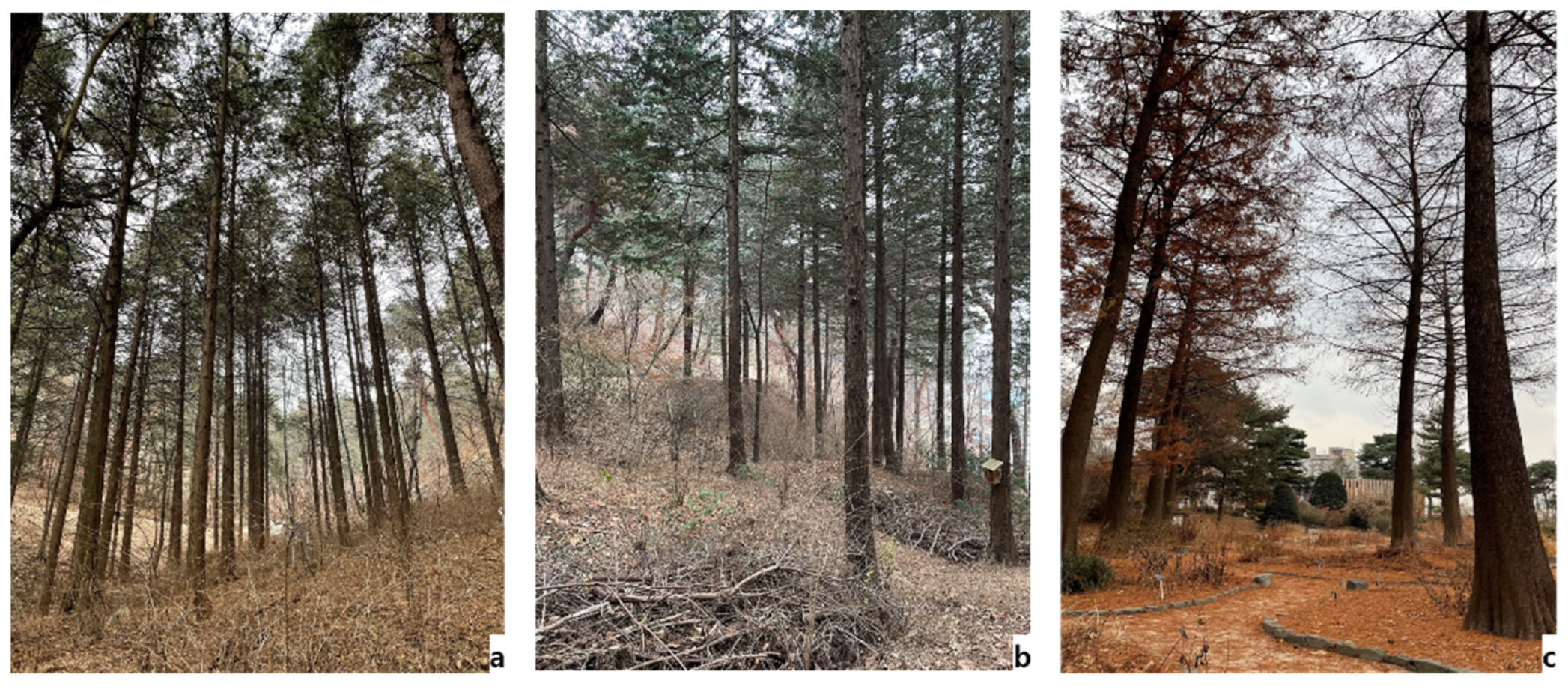



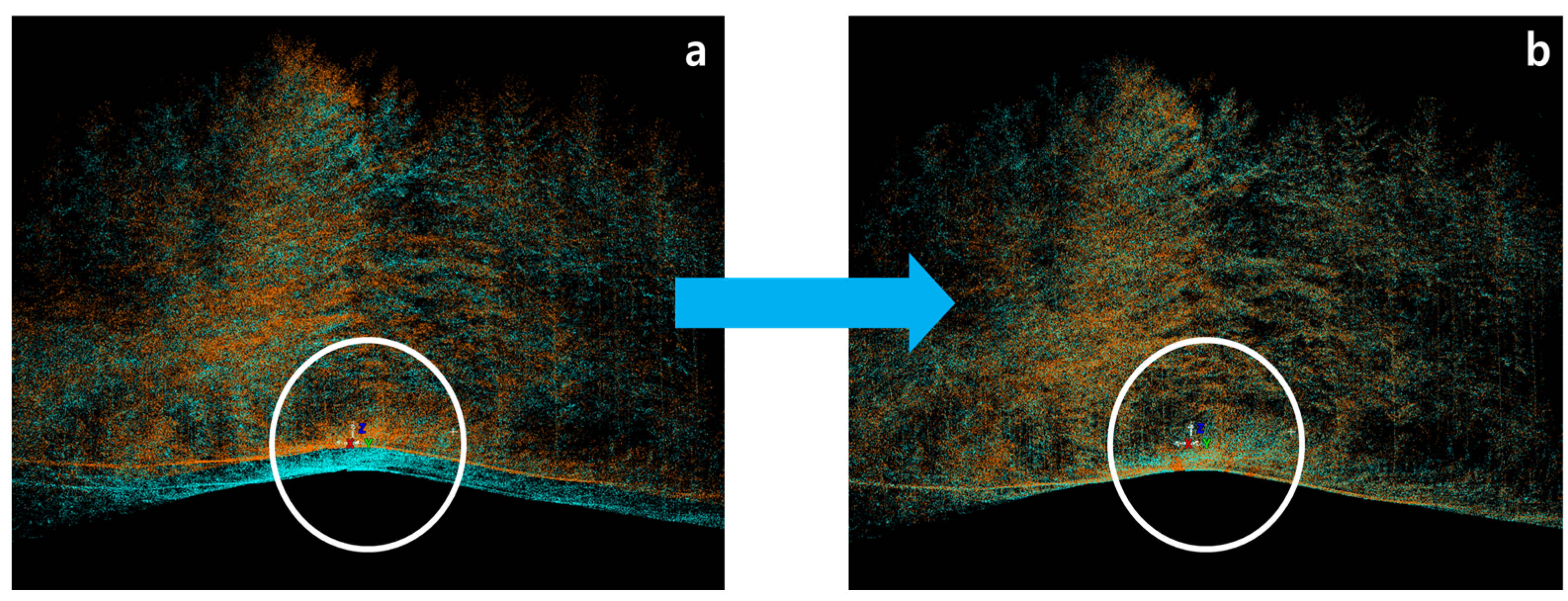
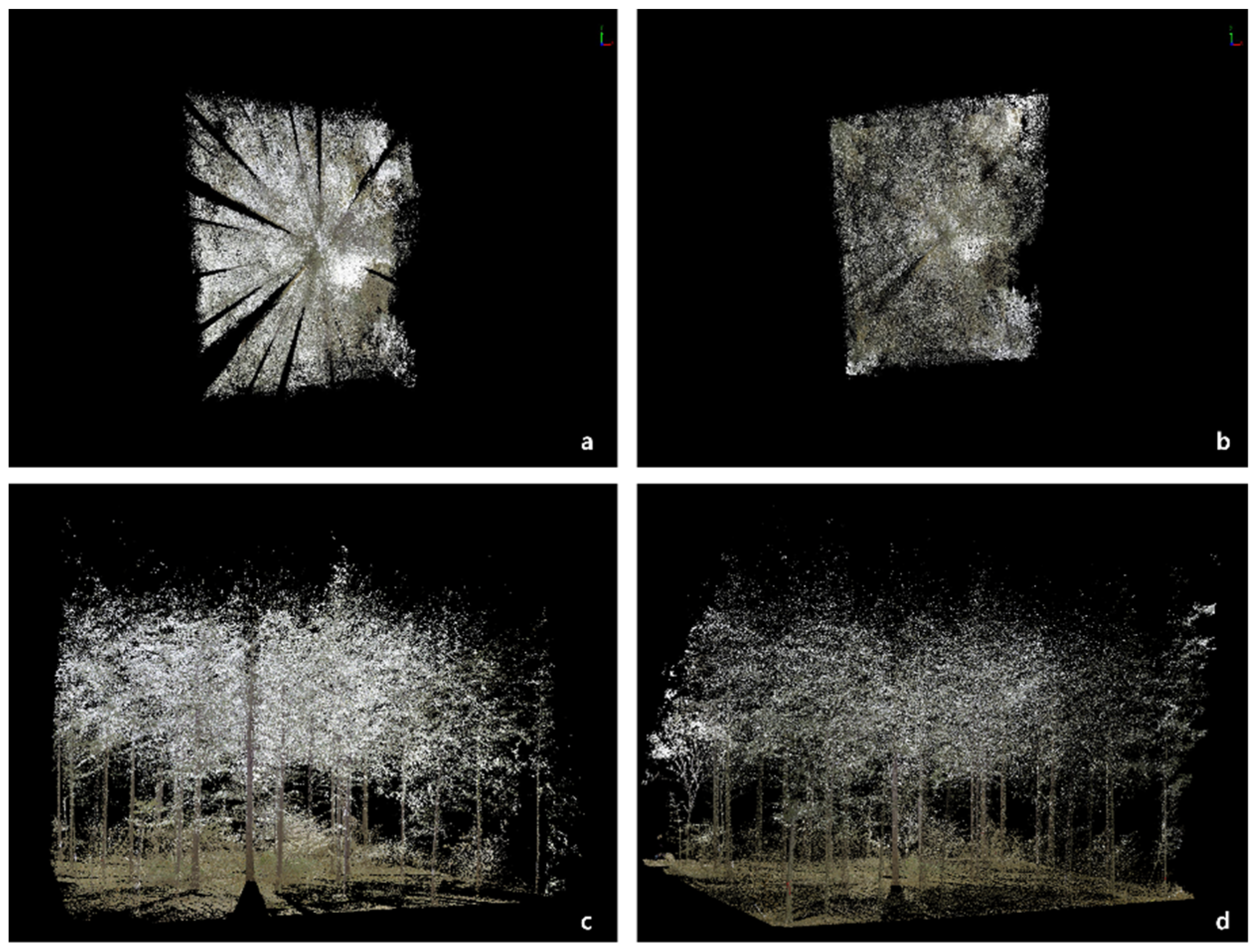
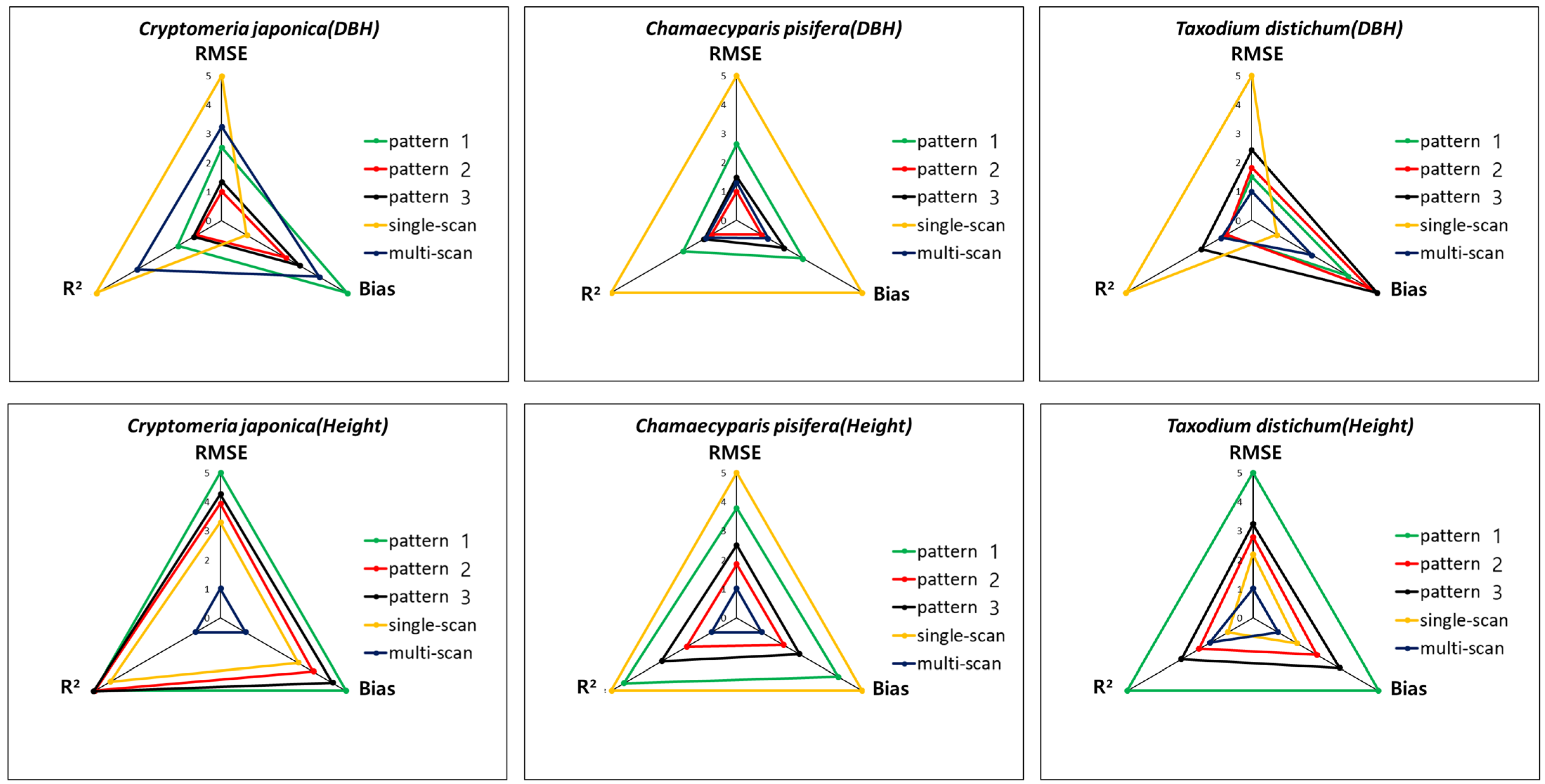
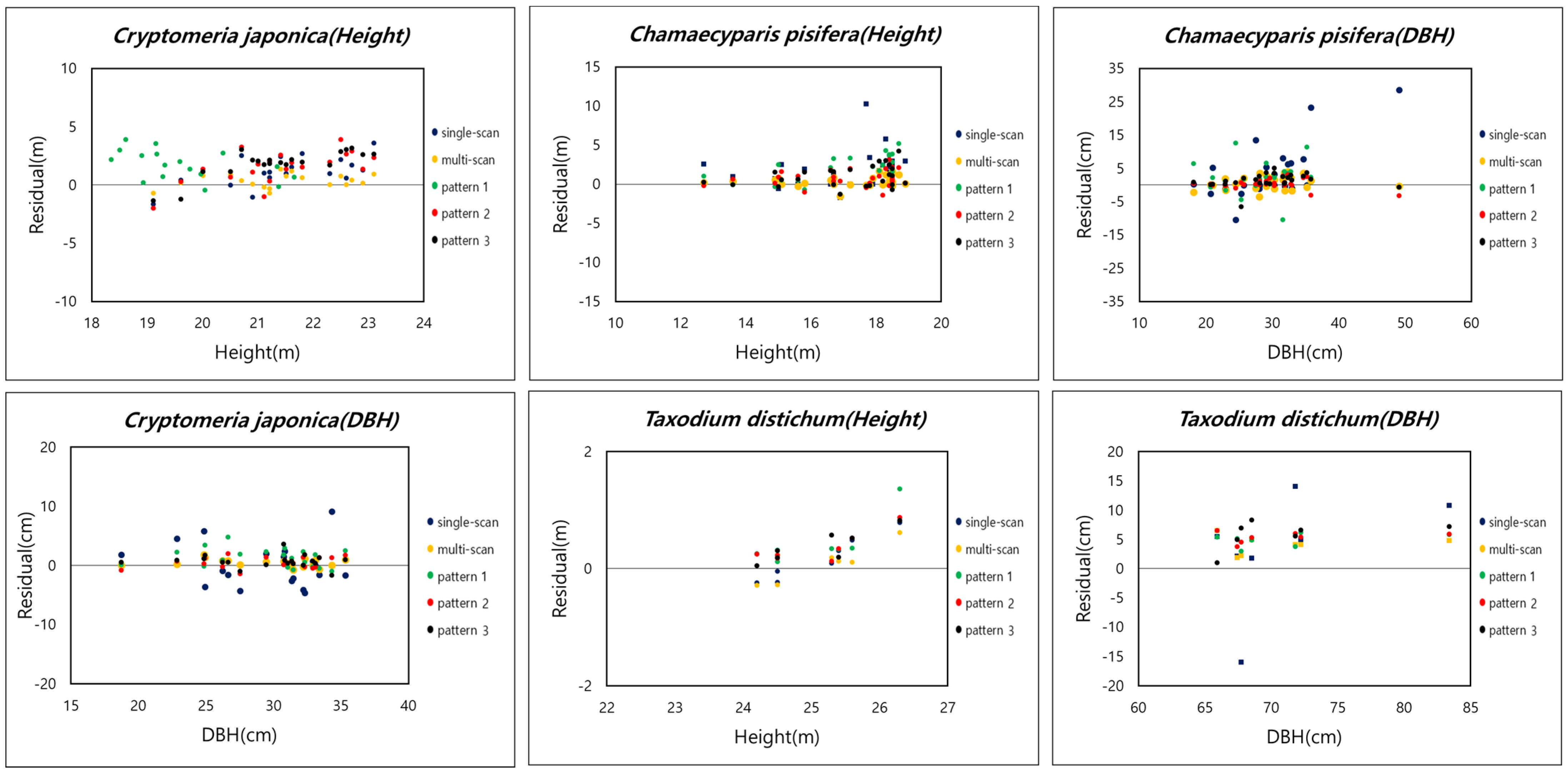
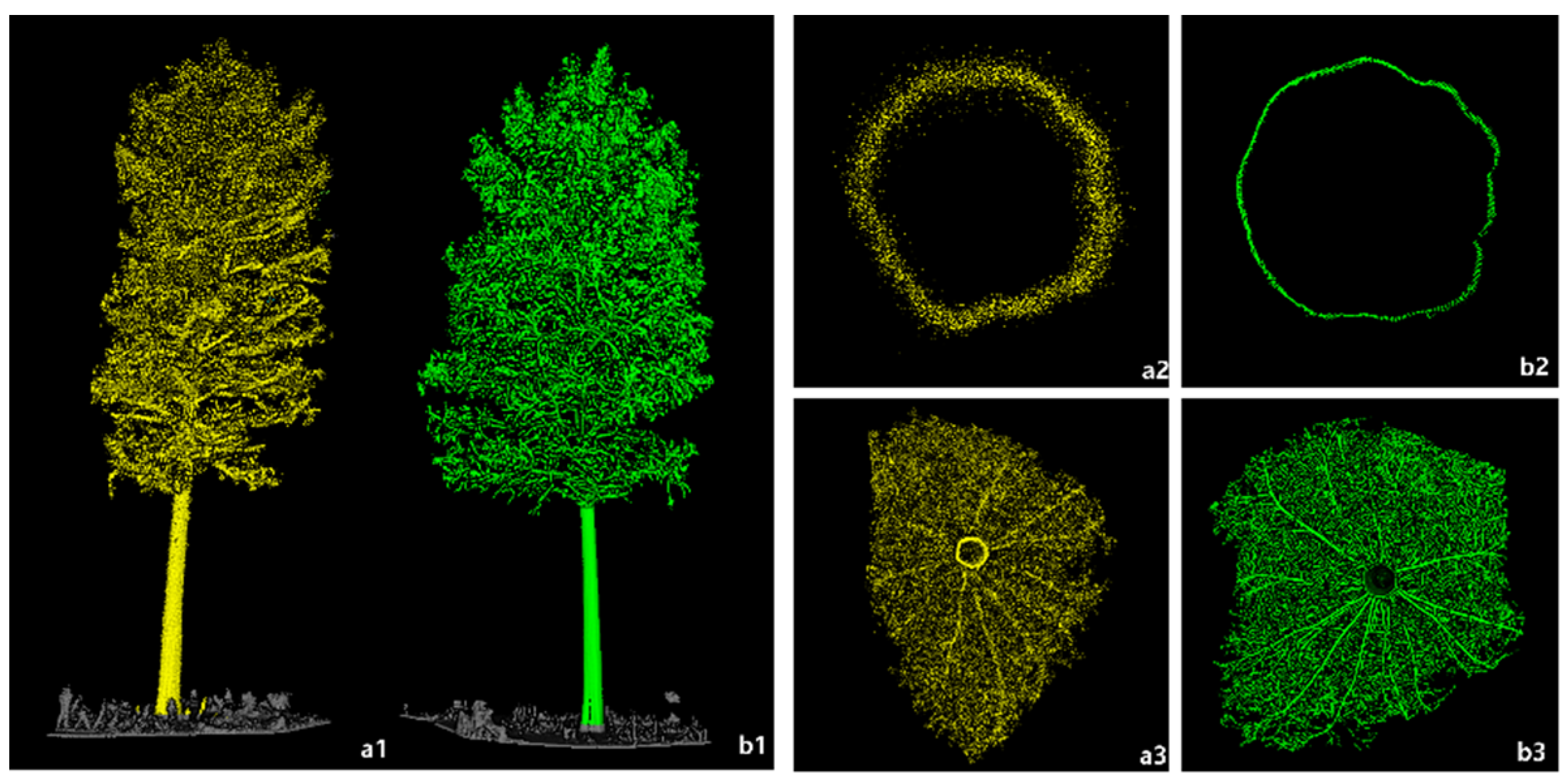

| Plot Species | Plot Size (ha) | Altitude (m) | Slope (°) | Wind Speed (m/s) |
|---|---|---|---|---|
| Cryptomeria japonica | 0.04 | 65 | 24 | 3 |
| Chamaecyparis pisifera | 0.04 | 37 | 8 | 3 |
| Taxodium distichum | 0.04 | 40 | 0 | 3 |
| Specifications | ||
|---|---|---|
| Laser Sensor | TLS (Leica RTC360) | BPLS (Velodyne VLP-16*2) |
| Wavelength | 1550 nm | 905 nm |
| LiDAR Accuracy | 1.9–5.3 mm (1.9 mm @ 10 m 2.9 mm @ 20 m 5.3 mm @ 40 m) | ±3 cm |
| Scan Range | 130 m | 100 m |
| Weight | 5.35 kg without battery | 8.8 kg without battery |
| Scan Rate | 2,000,000 pts/s | 600,000 pts/s |
| Field of view | vertical: 300° horizonal: 360° | vertical: −90°–+90° horizonal: 360° |
| Camera | 36 MP 3-camera system 432 MPx raw data for calibrated 360° × 300° spherical image | |
| Plot No. | Number of Trees | Stem Density (Trees/ha) | DBH (cm) | Tree Height (m) | Basal Area (m2/ha) | |||||||
|---|---|---|---|---|---|---|---|---|---|---|---|---|
| Mean | Std. | Min | Max | Mean | Std. | Min | Max | Mean | Std. | |||
| Cryptomeria japonica | 20 | 500 | 29.3 | 4.14 | 18.7 | 34.3 | 21.69 | 1.0 | 19.6 | 23.1 | 34.4 | 0.29 |
| Chamaecyparis pisifera | 26 | 650 | 29.3 | 6.20 | 18.1 | 49.1 | 17.05 | 1.70 | 12.7 | 18.9 | 45.6 | 0.34 |
| Taxodium distichum | 7 | 175 | 71.0 | 5.94 | 65.9 | 83.4 | 25.9 | 1.10 | 24 | 27.3 | 69.64 | 0.85 |
| Survey Method | Total Time Elapsed | |
|---|---|---|
| Field Work | Office Work | |
| Traditional field survey | Plot extraction, height estimation, DBH estimation | Digitization of field measurement |
| BPLS | Plot extraction Point cloud acquisition | Variable extraction using point cloud |
| TLS | Plot extraction Point cloud acquisition | Co-registration Variable extraction using point cloud |
| Statistics | Calculation Forms |
|---|---|
| ) | |
| Bias | |
| Bias% | |
| Root Mean Square Error (RMSE) | |
| Root Mean Square Error% (RMSE%) |
| Study Site | Reference | Mapped | Percentage (%) | |
|---|---|---|---|---|
| BPLS (Pattern 1) | Cryptomeria japonica | 20 | 20 | 100 |
| Chamaecyparis pisifera | 26 | 26 | 100 | |
| Taxodium distichum | 7 | 7 | 100 | |
| BPLS (Pattern 2) | Cryptomeria japonica | 20 | 20 | 100 |
| Chamaecyparis pisifera | 26 | 26 | 100 | |
| Taxodium distichum | 7 | 7 | 100 | |
| BPLS (Pattern 3) | Cryptomeria japonica | 20 | 20 | 100 |
| Chamaecyparis pisifera | 26 | 26 | 100 | |
| Taxodium distichum | 7 | 7 | 100 | |
| TLS (single-scan) | Cryptomeria japonica | 20 | 19 | 95 |
| Chamaecyparis pisifera | 26 | 23 | 88.46 | |
| Taxodium distichum | 7 | 7 | 100 | |
| TLS (multi-scan) | Cryptomeria japonica | 20 | 20 | 100 |
| Chamaecyparis pisifera | 26 | 26 | 100 | |
| Taxodium distichum | 7 | 7 | 100 | |
| Study Site | Statistic | DBH (cm) | Height (m) | ||||||||
|---|---|---|---|---|---|---|---|---|---|---|---|
| Pattern 1 | Pattern 2 | Pattern 3 | Single-scan | Multi-scan | Pattern 1 | Pattern 2 | Pattern 3 | Single-scan | Multi-scan | ||
| Cryptomeria japonica | RMSE | 1.99 | 1.02 | 1.24 | 3.57 | 2.45 | 2.49 | 2.03 | 2.17 | 1.75 | 0.76 |
| RMSE% | 6.75 | 3.46 | 4.20 | 12.11 | 8.30 | 11.63 | 9.49 | 10.13 | 8.20 | 3.58 | |
| Bias | −1.29 | −0.52 | −0.68 | −0.03 | −0.94 | −2.04 | −1.51 | −1.82 | −1.27 | −0.42 | |
| Bias% | −4.38 | −1.76 | −2.32 | −0.10 | −3.19 | −9.55 | −7.04 | −8.51 | −5.93 | −1.95 | |
| R² | 0.90 | 0.96 | 0.95 | 0.64 | 0.77 | 0.04 | 0.04 | 0.03 | 0.14 | 0.70 | |
| Chamaecyparis pisifera | RMSE | 4.80 | 1.50 | 2.49 | 9.54 | 2.10 | 2.39 | 1.27 | 1.65 | 3.10 | 0.78 |
| RMSE% | 16.40 | 5.11 | 8.50 | 32.59 | 7.18 | 14.02 | 7.44 | 9.70 | 18.20 | 4.55 | |
| Bias | −2.12 | −0.40 | −1.34 | −4.58 | −0.66 | −1.70 | −0.76 | −1.03 | −2.08 | −0.38 | |
| Bias% | −7.22 | −1.35 | −4.56 | −15.65 | −2.25 | −10.0 | −4.45 | −6.02 | −12.18 | −2.20 | |
| R² | 0.68 | 0.95 | 0.88 | 0.003 | 0.90 | 0.28 | 0.68 | 0.52 | 0.2 | 0.84 | |
| Taxodium distichum | RMSE | 5.0 | 5.41 | 6.20 | 9.52 | 4.35 | 0.58 | 0.43 | 0.46 | 0.39 | 0.31 |
| RMSE% | 7.04 | 7.62 | 8.74 | 13.41 | 6.13 | 2.33 | 1.72 | 1.81 | 1.56 | 1.21 | |
| Bias | −4.89 | −5.34 | −5.51 | −3.33 | −4.09 | −0.41 | −0.22 | −0.29 | −0.16 | −0.10 | |
| Bias% | −6.88 | −7.53 | −7.77 | −4.69 | −5.76 | −1.62 | −0.88 | −1.16 | −0.65 | −0.40 | |
| R² | 0.97 | 0.98 | 0.74 | 0.02 | 0.93 | 0.66 | 0.86 | 0.81 | 0.94 | 0.89 | |
| Study Site | Variable | Sum of Squares | Mean Square | F | p-Value |
|---|---|---|---|---|---|
| Cryptomeria japonica | Height | 24.19 | 12.09 | 9.59 | <0.005 |
| DBH | 21.90 | 10.95 | 0.56 | 0.57 | |
| Chamaecyparis pisifera | Height | 7.46 | 3.73 | 1.24 | 0.30 |
| DBH | 5.70 | 2.85 | 0.07 | 0.93 | |
| Taxodium distichum | Height | 0.17 | 0.08 | 0.26 | 0.77 |
| DBH | 109.24 | 54.62 | 1.59 | 0.23 |
| Study Site | Equipment | Mean | Tukey Grouping |
|---|---|---|---|
| Cryptomeria japonica | Vertex | 21.39 | A |
| TLS | 20.97 | A | |
| BPLS | 19.88 | B |
| Study Site | Variable | Equipment | Number of Trees | Mean | S.D. | S.E. | t Value | Pr > |t| |
|---|---|---|---|---|---|---|---|---|
| Cryptomeria japonica | Height | TLS (multi-scan) | 20 | 20.97 | 1.37 | 1.17 | 4.00 | <0.005 |
| BPLS (Pattern 2) | 19.88 | 1.21 | 1.10 | |||||
| DBH | TLS (multi-scan) | 30.42 | 23.03 | 4.80 | 2.79 | 0.011 | ||
| BPLS (Pattern 2) | 28.96 | 17.20 | 4.15 | |||||
| Chamaecyparis pisifera | Height | TLS (multi-scan) | 26 | 16.67 | 2.89 | 1.70 | 1.97 | 0.059 |
| BPLS (Pattern 2) | 16.29 | 3.29 | 1.81 | |||||
| DBH | TLS (multi-scan) | 28.62 | 38.45 | 6.20 | −0.65 | 0.523 | ||
| BPLS (Pattern 2) | 28.88 | 44.14 | 6.64 | |||||
| Taxodium distichum | Height | TLS (multi-scan) | 7 | 25.01 | 0.27 | 0.52 | 1.80 | 0.121 |
| BPLS (Pattern 2) | 24.89 | 0.16 | 0.40 | |||||
| DBH | TLS (multi-scan) | 66.90 | 35.12 | 5.93 | 3.86 | <0.005 | ||
| BPLS (Pattern 2) | 65.64 | 32.84 | 5.73 |
| Study Site | Pattern | Area [m²] | Travel Distance [m] | Time Consumption [min] | Total Point Cloud [n] | Efficiency by the Distance Covered per Minute [m/min] | ||
|---|---|---|---|---|---|---|---|---|
| Survey [min] | Processing [min] | Total Times [min] | ||||||
| (A) | (B) | (C) | (D) = (B)/(C) | |||||
| Cryptomeria japonica | 1 | 400 | 80 | 4.09 | 14.47 | 18.57 | 5,959,489 | 4.31 |
| 2 | 200 | 7.43 | 25.06 | 32.50 | 14,062,705 | 6.15 | ||
| 3 | 160 | 6.05 | 22.70 | 28.75 | 12,198,763 | 5.57 | ||
| Chamaecyparis pisifera | 1 | 80 | 3.95 | 16.02 | 19.97 | 7,295,071 | 4.01 | |
| 2 | 200 | 7.15 | 28.81 | 35.96 | 19,135,965 | 5.56 | ||
| 3 | 160 | 6.43 | 28.25 | 34.67 | 13,402,931 | 4.61 | ||
| Taxodium distichum | 1 | 80 | 2.97 | 6.46 | 9.43 | 3,407,910 | 8.48 | |
| 2 | 200 | 5.91 | 10.17 | 16.08 | 7,157,977 | 12.44 | ||
| 3 | 160 | 4.84 | 7.32 | 12.14 | 4,946,240 | 13.17 | ||
| Study Site | Pattern | Area [m²] | Travel Distance [m] | Time [min] | Total Point Cloud [n] | Efficiency as the Distance Covered per Minute [m/min] | Efficiency as the Area Covered per Minute [m²/min] | ||
|---|---|---|---|---|---|---|---|---|---|
| Survey [min] | Processing [min] | Total Times [min] | |||||||
| (A) | (B) | (C) | (D) = (B)/(C) | (E) = (A)/(C) | |||||
| Cryptomeria japonica | single scan | 400 | 0 | 4.32 | 21.02 | 25.34 | 23,558,038 | 0.00 | 15.78 |
| multi scan | 28.3 | 21.18 | 68.96 | 90.14 | 70,306,600 | 0.31 | 4.44 | ||
| Chamaecyparis pisifera | single scan | 0 | 4.55 | 23.62 | 28.16 | 24,399,432 | 0.00 | 14.20 | |
| multi scan | 28.3 | 18.91 | 65.93 | 84.84 | 52,962,020 | 0.33 | 4.71 | ||
| Taxodium distichum | single scan | 0 | 3.86 | 14.00 | 17.87 | 21,230,763 | 0.00 | 22.39 | |
| multi scan | 28.3 | 17.98 | 42.16 | 60.13 | 60,482,287 | 0.47 | 6.65 | ||
| Study Site | Survey Method | Personnel | Area (m²) | Time Consumption [min] | Survey Coverage per Surveyor (m²/min) | |||
|---|---|---|---|---|---|---|---|---|
| Outdoor Task | Indoor Task | Total | ||||||
| Co-Registration | Processing | |||||||
| Cryptomeria japonica | Field survey | 3 | 400 | 16.98 | 0 | 3.27 | 20.25 | 6.58 |
| BPLS(Pattern 2) | 1 | 7.433 | 0 | 25.06 | 32.50 | 12.31 | ||
| TLS(multi-scan) | 1 | 21.18 | 30 | 28.96 | 90.14 | 4.44 | ||
| Chamaecyparis pisifera | Field survey | 3 | 27.13 | 0 | 4.1 | 31.23 | 4.27 | |
| BPLS(Pattern 2) | 1 | 7.148 | 0 | 28.81 | 35.96 | 11.12 | ||
| TLS(multi-scan) | 1 | 18.91 | 25 | 40.93 | 84.84 | 4.71 | ||
| Taxodium distichum | Field survey | 3 | 6.58 | 0 | 2.1 | 8.68 | 15.36 | |
| BPLS(Pattern 2) | 1 | 5.905 | 0 | 10.17 | 16.08 | 24.88 | ||
| TLS(multi-scan) | 1 | 17.98 | 15 | 27.15 | 60.13 | 6.65 | ||
Publisher’s Note: MDPI stays neutral with regard to jurisdictional claims in published maps and institutional affiliations. |
© 2022 by the authors. Licensee MDPI, Basel, Switzerland. This article is an open access article distributed under the terms and conditions of the Creative Commons Attribution (CC BY) license (https://creativecommons.org/licenses/by/4.0/).
Share and Cite
Ko, C.; Lee, J.; Kim, D.; Kang, J. The Application of Terrestrial Light Detection and Ranging to Forest Resource Inventories for Timber Yield and Carbon Sink Estimation. Forests 2022, 13, 2087. https://doi.org/10.3390/f13122087
Ko C, Lee J, Kim D, Kang J. The Application of Terrestrial Light Detection and Ranging to Forest Resource Inventories for Timber Yield and Carbon Sink Estimation. Forests. 2022; 13(12):2087. https://doi.org/10.3390/f13122087
Chicago/Turabian StyleKo, ChiUng, JooWon Lee, Donggeun Kim, and JinTaek Kang. 2022. "The Application of Terrestrial Light Detection and Ranging to Forest Resource Inventories for Timber Yield and Carbon Sink Estimation" Forests 13, no. 12: 2087. https://doi.org/10.3390/f13122087
APA StyleKo, C., Lee, J., Kim, D., & Kang, J. (2022). The Application of Terrestrial Light Detection and Ranging to Forest Resource Inventories for Timber Yield and Carbon Sink Estimation. Forests, 13(12), 2087. https://doi.org/10.3390/f13122087






